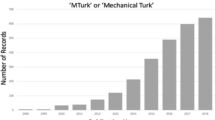Abstract
Responsiveness is an important factor to be considered in human-computer interfaces. With the advent of touch screen based smartphones and the evolve of more responsive technology, the user-acceptable levels of response time have changed considerably. However, previous studies have focused more on computers than on smartphones. The goal of this study was to explore the relationship between response time and user perception in the context of smartphone interactions. Different response times from 300 to 5400 ms were manipulated for four common task types in three applications, this simulation enables us to collect users’ subjective evaluations and physiological measures including pupil dilation and galvanic skin response. The applicability of Web-Fechner Law is demonstrated when the response time is in milliseconds. Results also showed statistically significant effects from task type and loading animation. Users have lower tolerance when they swipe to switch pages and have greater tolerance on interfaces with a loading animation, which provide the developers with clearer design requirements guidance.
Access this chapter
Tax calculation will be finalised at checkout
Purchases are for personal use only
Similar content being viewed by others
References
Hoxmeier, J.A., DiCesare, C.: System response time and user satisfaction: In: An experimental study of browser-based applications. AMCIS 2000 Proceedings, p. 347 (2000)
Galletta, D.F., et al.: Web site delays: how tolerant are users? J. Assoc. Inf. Syst. 5(1), 1 (2004)
Rangardt, J., Czaja, M.: Empirical investigation of how user experience is affected by response time in a web application (2017)
Lee, D., et al.: Antecedents and consequences of mobile phone usability: linking simplicity and interactivity to satisfaction, trust, and brand loyalty. Inf. Manag. 52(3), 295–304 (2015)
Wu, G., Wu, G.: Conceptualizing and measuring the perceived interactivity of websites. J. Curr. Issues Res. Advert. 28(1), 87–104 (2006)
Johnson, G.J., Bruner II, G.C., Kumar, A.: Interactivity and its facets revisited: theory and empirical test. J. Advert. 35(4), 35–52 (2006)
Song, J.H., Zinkhan, G.M.: Determinants of perceived web site interactivity. J. Mark. 72(2), 99–113 (2008)
Anderson, G., Doherty, R., Ganapathy, S.: User perception of touch screen latency. In: International Conference of Design, User Experience, and Usability. Springer, Heidelberg (2011)
Ng, A., et al.: Designing for low-latency direct-touch input. In: Proceedings of the 25th annual ACM symposium on User interface software and technology. ACM (2012)
Jota, R., et al.: How fast is fast enough?: a study of the effects of latency in direct-touch pointing tasks. In: Proceedings of the SIGCHI Conference on Human Factors in Computing Systems. ACM (2013)
Ritter, W., Kempter, G., Werner, T.: User-acceptance of latency in touch interactions. In: International Conference on Universal Access in Human-Computer Interaction. Springer, Cham (2015)
Deber, J., et al.: How much faster is fast enough?: user perception of latency & latency improvements in direct and indirect touch. In: Proceedings of the 33rd Annual ACM Conference on Human Factors in Computing Systems. ACM (2015)
Antonides, G., Verhoef, P.C., Van Aalst, M.: Consumer perception and evaluation of waiting time: a field experiment. J. Consum. Psychol. 12(3), 193–202 (2002)
Egger, S., et al.: Waiting times in quality of experience for web based services. In: Fourth International Workshop on Quality of Multimedia Experience (QoMEX). IEEE (2012)
Zhou, R., et al.: How to define the user’s tolerance of response time in using mobile applications. In: IEEE International Conference on Industrial Engineering and Engineering Management (IEEM) 2016. IEEE (2016)
Miller, R.B.: Response time in man-computer conversational transactions. In: Proceedings of the December 9–11, 1968, fall joint computer conference, part I. ACM (1968)
Shneiderman, B., Designing the user interface: strategies for effective human-computer interaction. Pearson Education, India (2010)
Nah, F.F.-H.: A study on tolerable waiting time: how long are web users willing to wait? Behav. Inf. Technol. 23(3), 153–163 (2004)
Lee, Y., Chen, A.N., Ilie, V.: Can online wait be managed? the effect of filler interfaces and presentation modes on perceived waiting time online (2012)
Dawson, M., Schell, A., Filion, D.: The electrodermal system In: Cacioppo, J.T., Tassinary, L.G., Berntson, G.G. (eds.) Handbook of psychophysiology, pp. 159–181. Cambridge University Press, New York (2007)
Mandryk, R.L., Inkpen, K.M., Calvert, T.W.: Using psychophysiological techniques to measure user experience with entertainment technologies. Behav. Inf. Technol. 25(2), 141–158 (2006)
Wenjun, H., Xiaoyu, G., Tiemeng, L.: Customer satisfaction evaluation model based on pupil size changes. Space Med. Med. Eng. 5, 001 (2013)
Acknowledgments
The research was supported by National Natural Science Foundation of China (61402159, 51605154). We would like to thank all participants for their zeal during the experiments.
Author information
Authors and Affiliations
Corresponding author
Editor information
Editors and Affiliations
Rights and permissions
Copyright information
© 2019 Springer International Publishing AG, part of Springer Nature
About this paper
Cite this paper
Tan, Z., Zhu, J., Chen, J., Li, F. (2019). The Effects of Response Time on User Perception in Smartphone Interaction. In: Ahram, T., Falcão, C. (eds) Advances in Usability, User Experience and Assistive Technology. AHFE 2018. Advances in Intelligent Systems and Computing, vol 794. Springer, Cham. https://doi.org/10.1007/978-3-319-94947-5_34
Download citation
DOI: https://doi.org/10.1007/978-3-319-94947-5_34
Published:
Publisher Name: Springer, Cham
Print ISBN: 978-3-319-94946-8
Online ISBN: 978-3-319-94947-5
eBook Packages: EngineeringEngineering (R0)




